NCC: Land Lines – Wetlands are our natural defences and need to be conserved
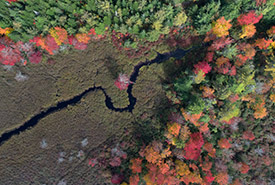
Upper Ohio, NS (Photo by Mike Dembeck)
During the recent UN Biodiversity Conference (COP15) in Montreal, over 190 nations adopted a Global Biodiversity Framework. Part of that agreement is to conserve at least 30 per cent of the world’s lands and waters by 2030. While it is not a legally binding agreement, people and communities want action. Here in Canada, the federal government has committed to this goal as a measure to address the twin crises of biodiversity loss and climate change. Some provinces have subsequently announced action plans.
One of our best natural defences to lessen the impacts of climate change are wetlands. Unfortunately, they also happen to be one of the world’s most threatened ecosystems.
Canada is home to 25 per cent of the world’s wetlands; more than any other country. Many have disappeared due to human activity, such as development and drainage. In southern Canada, where our communities are most settled, we have lost over 80 per cent of our original wetlands. In recognition of this, there needs to be a concerted effort to conserve our remaining wetlands — and fast.
Wetlands serve numerous valuable social, economic and ecological functions. They play an important role in purifying drinking water. They also provide vital wildlife habitat, flood mitigation, soil stabilization and recreational opportunities. As more and more wetlands are degraded or lost, the natural capacity to buffer floods from runoff and tidal forces is lessened, increasing the threat of major flooding.
Wetlands do a lot of things for us that people often take for granted or haven’t thought about. If you used water today to brush your teeth, cook or quench your thirst, you should probably thank a wetland! They protect our water quality by capturing sediment, nutrients and pollutants. Like a giant sponge, they absorb and replenish water to buffer flood and drought risks. They also trap and store carbon.
Wetlands also provide important nesting and feeding grounds for waterfowl and many other animals. At least half of the species in North America rely on them for at least part of their life cycle.
The Nature Conservancy of Canada (NCC) has protected and restored over 161,000 hectares of wetlands across the country for the benefit of plants, animals and people. We have also contributed to the protection of over 57,000 kilometres of rivers and more than 496,000 hectares of lakes.
We are proud to work with private landowners, communities, governments and other organizations to conserve important habitats, including wetlands, floodplains and shores. We also restore wetlands that have been degraded, to improve these natural spaces for migratory birds, amphibians, fish and other species.
Here in Atlantic Canada, wetlands are among NCC’s most important habitats we are working to conserve. NCC has protected important wetland habitats from the northeastern tip of New Brunswick to the southwestern corner of Nova Scotia, and across to Prince Edward Island and Newfoundland and Labrador.
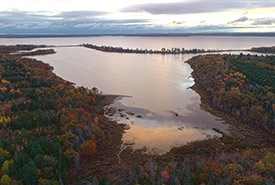
The Keyhole Nature Reserve connects to Grand Lake, the largest lake in the province and is part of the Wolastoq (St. John) River system. (Photo by Mike Dembeck/NCC)
In New Brunswick, we are working to protect forests and wetlands around the largest lake in the province, Grand Lake. Several species of plants and animals that were once abundant here are now rare or at risk, due to the long history of clearing and development along the shores of the lake. We have an immediate opportunity to purchase a 20-hectare wetland on the west side of the lake to expand The Keyhole Nature Reserve, near Grand Lake Provincial Park.
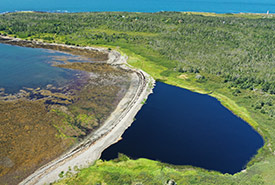
Brier Island, NS (Photo by Brainworks/NCC)
Since 1988, NCC has been actively working on Brier Island in Nova Scotia, conserving a crucial wetland habitat that is key to the survival of a diverse range of plants including several rare plants, such as eastern mountain avens. The area’s peat bogs are home to 95 per cent of the entire Canadian population of eastern mountain avens — one of only two regions in the world where this rare flowering plant can be found. Our efforts include working with research groups, local volunteers and donors to restore bogs and wetlands, which also serve as a rich habitat for migrating birds on the Atlantic flyway. We are actively seeking opportunities and additional support to expand upon this nature reserve and protect existing biodiversity on the western tip of Nova Scotia.
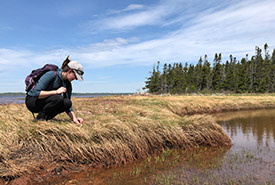
Percival River nature reserve is NCC’s largest nature reserve on PEI, and part of the largest, unbroken tract of contiguous salt marsh in the province. The area is home to ecologically rich wetland habitat and coastal forest. (Photo by NCC)
One of the shining examples of wetlands on Prince Edward Island is located along the Percival River in Prince County. The Percival River area represents one of the most intact habitat corridors remaining in the province. Since 2007, NCC has been protecting coastal salt marsh, freshwater wetlands and nearby black spruce forest in the area. NCC is proud to be joined by our Island conservation partners who are also working along the shorelines of the Percival River in recognition of the critical forest and coastline habitat that occurs here. The largest unbroken tract of salt marsh in PEI is located along the Percival River.
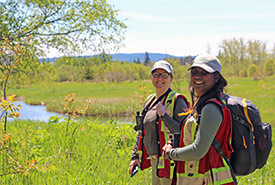
NCC staff conducting fieldwork at the Black Ash Nature Reserve, NL. (Photo by Triina Voitk/NCC staff)
Newfoundland and Labrador’s 11-hectare Black Ash Nature Reserve features marshland and floodplain forests along Rocky Brook, less than two kilometres from the town of Deer Lake. Located within the Upper Humber River Floodplain, this unique property floods seasonally, making it great habitat for provincially rare species, such as black ash, rusty blackbird and great blue heron.
In addition to their importance for nature, many of NCC-protected wetland areas provide recreational opportunities, such as walking, hiking, fishing, wildlife viewing and canoeing, along with educational opportunities for people of all ages to learn and explore.
As we collectively face the dual crises of biodiversity loss and climate change, it will take everyone — individuals, communities, governments, businesses, conservation groups and Indigenous communities — to work together for the protection of wetlands.




